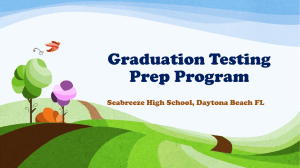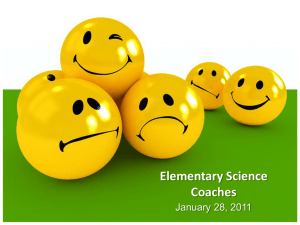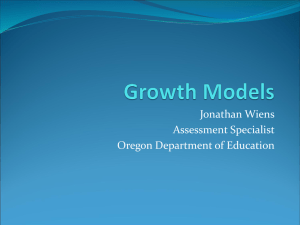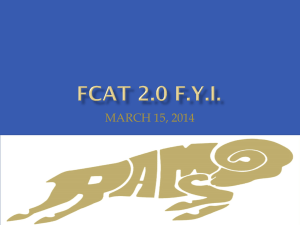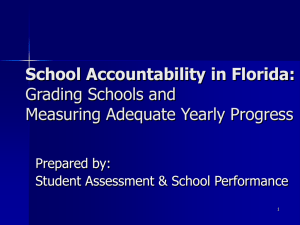Elements and Indicators and Common Language
advertisement
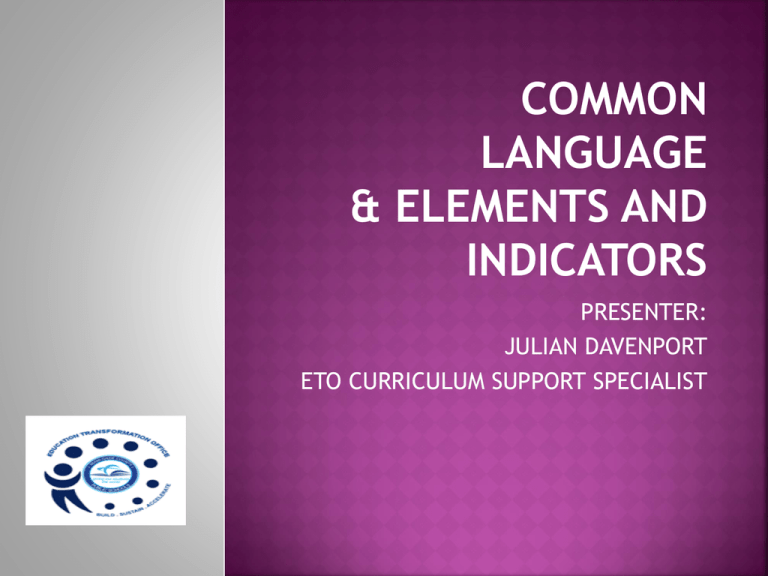
COMMON LANGUAGE & ELEMENTS AND INDICATORS PRESENTER: JULIAN DAVENPORT ETO CURRICULUM SUPPORT SPECIALIST In order to be an effective Instructional Coach in the ETO, you have to be able to speak the language of ETO. Rules: I will display a commonly used ETO acronym and the first person to identify what it stands for will receive a prize. Then we will talk about what each of the acronyms represent and the purpose of each. E.T.O. Established in Miami by Assistant Superintendent Nikolai Vitti with the S.I.G. funds provided by the federal government to turn around the “chronically lowest performing schools.” Build Instruction Leaders Ensure High Quality, Effective Teaching Use Data to Make Decisions on Instruction, Interventions, and Enrichment Build a Bench of High Performing Teachers and Leaders for Sustainability. Provide job embedded professional development focused on deep teaching of standards, lesson planning, data analysis and student interventions. NGSSS Define the content, knowledge, and abilities that a K-12 student is expected to have mastered at the end of each grade level or course. Provide guidance to teachers when setting instructional goals by clarifying the depth of knowledge expected. Provide a framework for textbooks and other instructional materials. Increase depth, understanding, process skills, and proficiency Lead to mastery of concepts and skills covering understanding FCAT 2.0 Aligns with the Next Generation Sunshine State Standards (NGSSS) in Reading, Math, and now Science. Reading consists of Multiple Choice Items only Math consists of MC and Gridded Response Scores on the new FCAT Scale will be available in 2012. FCAT 2.0 Reading Breakdown FCAT 2.0 Reading Breakdown FCAT 2.0 Math Breakdown FCAT 2.0 Writing Breakdown Starting this past year, students must score a Level 4 or above to receive credit for school grade. Students must score a Level 3 for AYP. FCAT 2.0 Science Breakdown Will be assessed in Grades 5, 8, and 11 starting with the 2012 FCAT 2.0. CBC Purpose of the Common Board Configuration -Set the purpose for today’s instruction -Draw connections to previous lessons, upcoming lessons, or real life connections. -Guide the instruction through the use of essential questions that embody the concepts. -Introduce key vocabulary DATE: June 21, 2011 BELL RINGER: Make an appointment. VOCABULARY: interventions, enrichment, accountability groups, interventionists BENCHMARK: Interventions OBJECTIVE: Today we will examine the role Interventions and Enrichment play in our work to improve student achievement by identifying it’s purpose, reviewing materials used for interventions, and looking at how to develop an effective intervention routine. ESSENTIAL QUESTION: Why is having a strong plan for interventions/enrichment such an important part of your role as an instructional math coach? • • • • • • • AGENDA: Access prior knowledge: What is Intervention? Who Goes to Intervention? What Types of Intervention? Intervention Materials Getting Started • Selecting Interventionist • Setting Up for Interventions Your Turn (Activity) Journal Reflection: How does this affect teacher performance and student achievement? EXIT SLIP: IN YOUR JOURNAL Connect: Write about 3 new things that you learned today and how this will help you as an instructional mathematics coach. Connect:Why is having a strong plan for interventions/enrichment such an important part of your role as an instructional math coach? HOME LEARNING: Review today’s lesson and develop your next steps to share this information with teachers at your school EQ Overarching, higher order questions that yield inquiry and argument, and are intended to result in conclusions drawn by the learner. Designed to provoke and sustain student inquiry. Address conceptual foundations of an objective. Stimulate ongoing, rethinking of big ideas, assumptions and prior lessons, and may raise other important questions. Understanding by Design, 2004 DOK Webb’s Levels of Cognitive Complexity Low Complexity relies on the recall and recognition of previously learned concepts and principles Moderate Complexity involves more flexible thinking and choice among alternatives High Complexity requires students to engage in more abstract reasoning, planning, analysis, judgment, and creative thinking HOTS Promote critical, independent, and creative thinking Inquiry methods and questioning strategies promote deeper understanding “Think Alouds” Use of adequate “wait time” Accountable talk Students use a variety of methods to communicate ideas and/or procedures. Discussion is promoted IFC Driven by data DA The Florida model for Differentiated Accountability (DA) aligns and integrates federal and state accountability systems to allow implementation of school improvement strategies that will have the greatest impact on low-performing schools. The model differentiates among schools based on school grade and percent of Adequate Yearly Progress (AYP) criteria met. Prevent I – Schools graded A, B, C with > 80% AYP criteria met School directs intervention District provides assistance State reviews progress (monitors/reports) Correct I – Schools graded A, B, C with > 80% AYP criteria met School complies with district determined measures District directs intervention and provides planning State provides assistance, monitors and reports Prevent II – Schools graded D or F with < 80% AYP criteria met School complies with district determined success District directs intervention, provides planning and assistance State provides assistance, monitors and reports Correct II – Schools graded D or F with < 80% AYP criteria met School complies with the state-directed interventions District complies with state-directed interventions State directs intervention, monitors and reports Is a category in Florida's school accountability system Means that there will be heightened level of district and state support for academic and behavior programs Exiting intervene requires a school to meet AYP, through one of the options, in at least one subgroup for reading and one subgroup for math. AYP Adequate Yearly Progress (AYP) measures progress of all public schools, and school districts toward enabling all students to meet the State’s academic achievement standards. Measurements target the performance and participation of various subgroups based on race or ethnicity, socioeconomic status, disability, and English proficiency. Meeting the goals set by the State Ninety-five percent of all students and all subgroups must participate in the state assessment program in order for a school or district to make AYP. Safe Harbor-schools must show an increase of 10 percent of the nonproficient students from the year before. In addition, all schools must demonstrate a 1 percent improvement in the percentage of students proficient in Writing and high schools must also demonstrate a 1 percent improvement in its graduation rate. PLC Engaging students, teachers, and administrators in the process of continuously seeking and sharing knowledge. The goal of PLCs is to enhance our effectiveness as professionals so that ultimately the students benefit. LS Lesson study is a professional development approach that •Focuses on examining instruction. •Explores real challenges teachers face in their classrooms •Builds teacher knowledge •Supports professional collaboration LESSON STUDY PROCESS 1. Set a learning goal. Plan the lesson (collaboratively) Teaching and Observing Debriefing Revising and Reteaching Implementation in the Classroom Follow-Up 2. 3. 4. 5. 6. 7. PD Education Transformation Office (ETO) Professional Development -Coaches Meetings (usually once a month) -Job Embedded Professional Development by ISs and CSSs -Traditional Professional Development (as needed) DI What is Differentiated Instruction? -Tailoring your instruction to meet the Individual needs of your students. All subjects areas will have an emphasis on differentiated instruction this year. Differentiated instruction can be addressed in different ways. -Whole group, small group rotations Differentiated by the data. instruction should be driven LOL The ETO model is driven by these indicators: I. II. III. IV. V. VI. VII. VIII. IX. X. Classroom Culture and Environment Instructional Tools & Materials Lesson Planning and Delivery Higher Order Questioning & Discourse Student Engagement Rigorous Tasks and Assessments Differentiated Instruction Cross Content Reading & Writing Instruction Florida’s Continuous Improvement Model School District Leadership 1. 2. 3. 4. At each of your seats, you have a playing card with a number. When I say go, you will meet with the people that have the same # as you. That is your indicator #. In your group, you will work together to describe the indicator and share what it would look like in the classroom. Write this on the chart paper provided. You will be given 10 minutes to complete your chart and be ready to present. Your group will have about 3 minutes to present out on your specific Indicator. SAMPLE CHART How does speaking the “ETO Language” and knowing the Elements and Indicators help drive your work as a coach?

